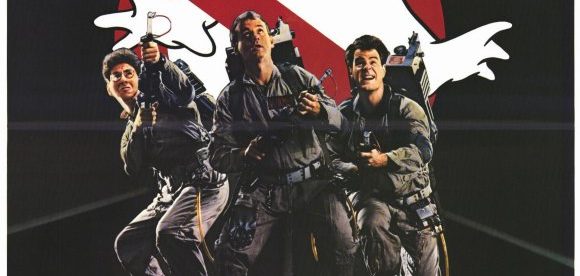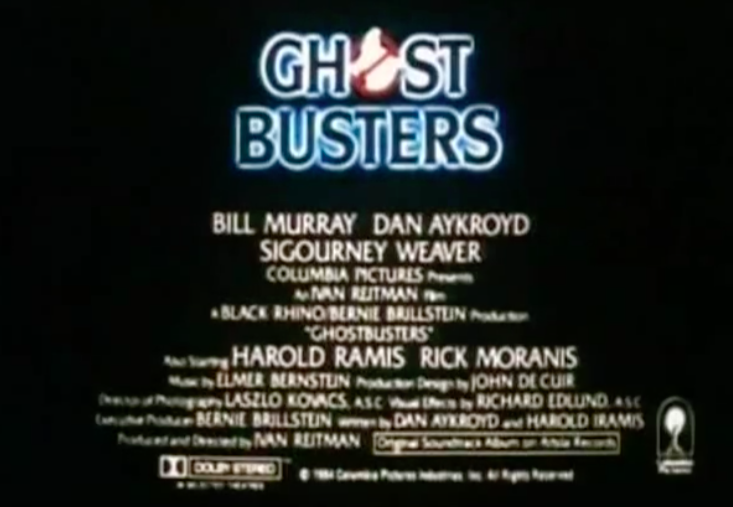Who You Gonna Call? Not This Ghostbuster


In 1984, movie fans received in gift in the form of a sci-fi comedy titled Ghostbusters. The film proved immediately popular — by the end of the year, its take at the box office made it not only the highest-grossing film of the year but also the highest-grossing comedy of all time. The movie is regularly included on lists of top movies, and its success warranted a sequel five years later, a cartoon TV series, a movie-quality video game in 2009, and a theatrical reboot just a couple years ago. If you were involved in the film, it was certainly a highlight of your career.
And yet, there’s something strange in the poster above. You’ll note the three Ghostbusters are featured prominently. From left to right, there’s Harold Ramis, who plays Egon Spangler; then Bill Murray, in the role of Peter Venkman; and finally Dan Akroyd, as Ray Stantz. Under the trio are Murray’s and Akroyd’s names — along with Sigourney Weaver, they get top billing. Ramis and Rick Moranis get an “Also Starring” nod. If you watch the movie’s original theatrical trailer — click here if you have the two minutes — you’ll see the same. With about ten seconds left in the promo, all five actors are named, followed by this end screen, below.

But … there weren’t three Ghostbusters. There were four. While Spangler, Venkman, and Stantz founded the poltergeist-fighting organization, about midway through the movie they realized they needed to expand. The hired a guy named Winston Zeddmore — whose background really isn’t fleshed out much in the film — at an annual salary of $11,500. (That’s only about $28,000 in today’s dollars, which as Zeddmore points out, isn’t worth it for a role which comes with a relatively high chance of being killed by an interdimensional being.) Zeddmore is played by Ernie Hudson, and Ernie Hudson isn’t mentioned in the trailer or depicted in the poster. He only gets about a half-second of stand-alone screen time in the trailer, plus a few moments in the background here and there.
That wasn’t how it was supposed to be. Years later, Hudson penned an article for Entertainment Weekly, talking about how his experience with the film was bittersweet. While he was thrilled to be part of such an iconic project, he had hoped for so much more. “When I originally got the script,” he wrote,” the character of Winston was amazing and I thought it would be career-changing. The character came in right at the very beginning of the movie and had an elaborate background: he was an Air Force major something, a demolitions guy. It was great.” But the studio wanted to beef up Murray’s part. That change came at Hudson’s expense, communicated to him only when he received an updated script right before shooting.
And then it got worse. Comically so.
The success of the film certainly opened doors for Hudson, or at least made him recognizable — in 2012, he told The AV Club that “after all these years, almost 30 years later, whenever I’m on the street, someone will call out, ‘Who you gonna call?'” And he reprised the role of Zeddmore in the 1989 sequel to the 1984 blockbuster. But it didn’t secure him a job in other aspects of the Ghostbusters franchise. In 1986, Columbia Pictures Television decided to bring the Ghostbusters to the small screen in an animated TV show called The Real Ghostbusters. All four Ghostbusters were part of the plot but only Hudson wanted to voice his character — the other three weren’t interested. That should have made casting for his role easy — but Hudson didn’t get the part of Winston.
As Hudson told The AV Club, his interest in the role should have been enough — he knew how to play the character, after all. The producers were on-board, too, and there wasn’t even supposed to be an audition. He was, however, asked to come by and do a courtesy read for the director. But it went south, and fast:
I went in to read the material, and the guy said, “No, no, no, that’s all wrong! When Ernie Hudson did it in the movie…” And I’m like, “Well, wait a minute: I am Ernie Hudson!” [Laughs.] So when I left, they said, “No, it’s not a problem, you’re gonna do the voice.” They called me about it—I was shooting a film; I can’t remember what film I was doing—and then I never heard anything from them. Then I found out that Arsenio [Hall] was doing it. I was very busy doing other stuff, but I was really disappointed because the thought of someone else doing Winston was not something I felt great about. Arsenio’s a friend, so there’s no disrespect to him. But they had me come in and read, and even though they said I wasn’t auditioning, I dunno, I guess I was just there to have the director get on my nerves. Who knows what happened there? Whatever the case, I didn’t get the part. Unfortunately.
Oof.
Hudson, to his credit and resilience, still generally speaks fondly of his experience as a Ghostbuster. And in the official posters of Ghostbuster II, while his role still isn’t billed alongside the other three wielders of proton packs and positively-charged slime, he’s at least pictured alongside them. As for the 2009 video game, he and the other Ghostbusters of the original cast did the voice acting for their roles — and they didn’t even have to audition.
Bonus fact: Lorenzo Music ended up voicing the character of Peter Venkman in The Real Ghostbusters, but that wasn’t his main job. Music played the voice of Garfield (the cat) in the animated series and in TV specials throughout the 1980s and into the 1990s. Rumor has it that Music was selected for the ghostbusting role because Murray’s Venkman sounded like Music’s take on the cartoon cat — and there’s reason to believe that rumor. Music passed away in 2001, a few years before the Garfield franchise made its way to full-length feature films in 2004 and then a sequel in 2006. With Music no longer around, the producers went with the closest match they could think of — Bill Murray.
From the Archives: The Sword Isn’t So Mighty After All: Why was the 1986 cartoon called The Real Ghostbusters — emphasis on “Real”? The bonus item explains why.
